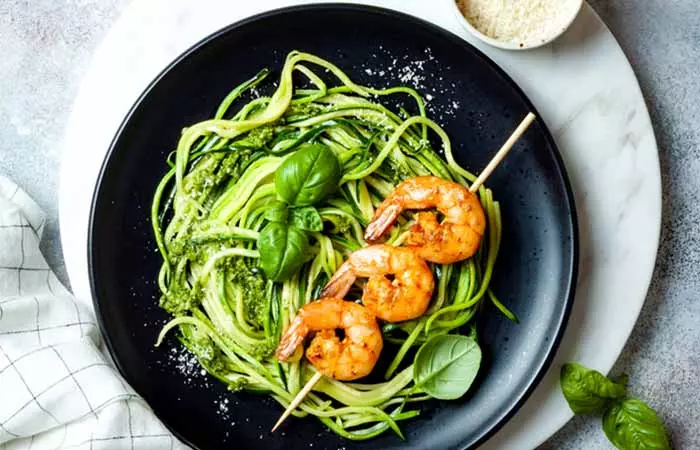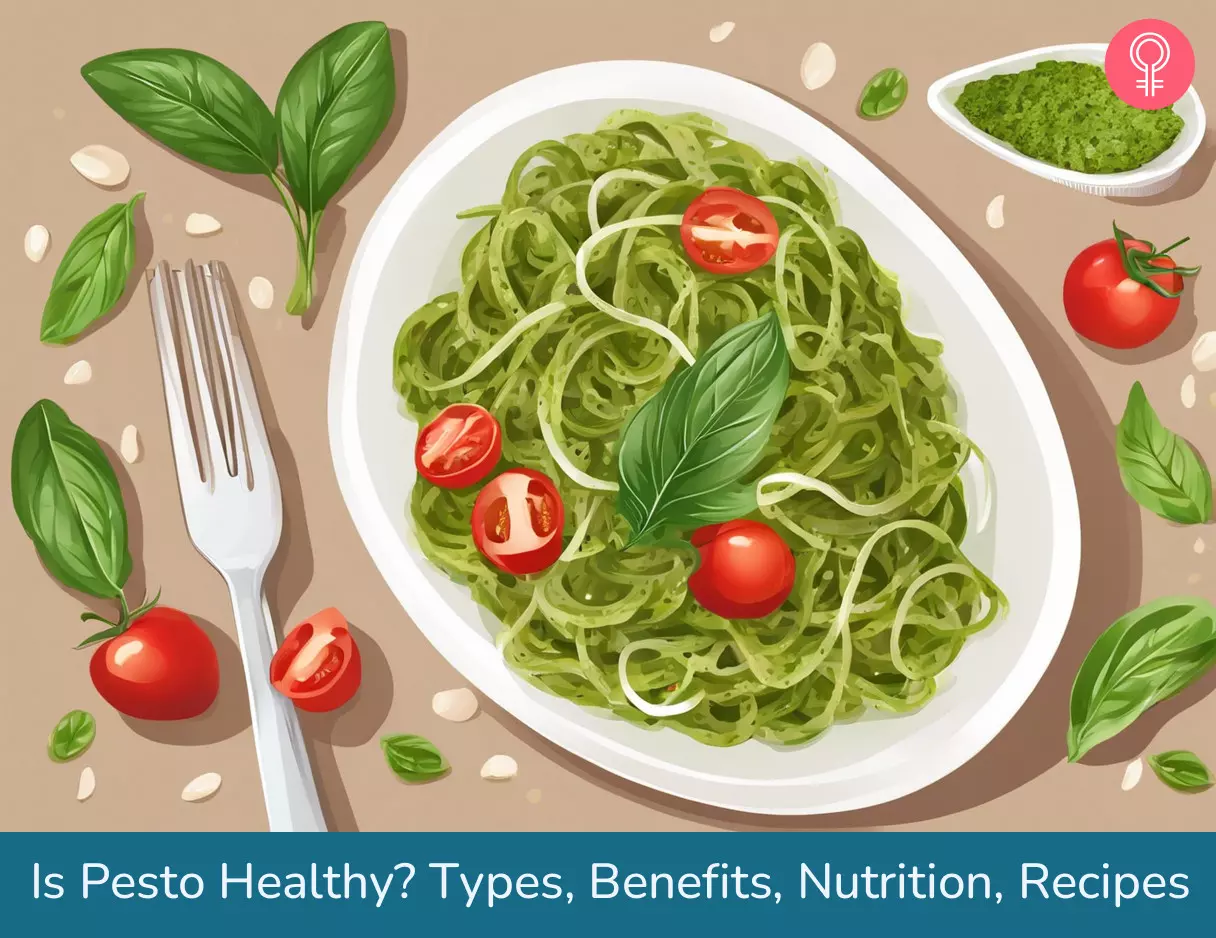What Are Its Benefits? It may improve blood sugar levels and skin health, reduce inflammation, and lower cholesterol levels Who Can Consume It? Anyone can consume this except people with a garlic or dairy allergy and those on a low-sodium diet. How Often? You can add 1 to 2 tablespoons of pesto to your food daily. Caution Excess and long-term consumption of pesto sauce may increase the risk of heart disease and stroke and cause an upset stomach.
Unlike your alfredo or barbecue sauce, pesto is an uncooked sauce. All you do is grind up these three ingredients using a mortar and pestle or a food processor and voila! Pesto is ready! You can now add it to your favorite pasta, toast, or even use it as a dip for chips and nachos.
Varieties Of Pesto
When it comes to pesto, you may belong to one of the two groups of people. In group one, you will find purists who will not modify the traditional recipe. In group two, you will find the more adventurous kind who enjoy experimenting with new recipes and adding a twist to traditional recipes. If you find yourself leaning towards group two, here are a few different types of pesto you can try.
Pesto Alla Trapanese
Pesto Alla Trapanese is popular in the Sicilian region of Italy. In this variant of pesto, the holy trinity of ingredients (basil, parmesan cheese, and extra-virgin olive oil) remains the same. The twist comes in with the addition of Pachino tomatoes, garlic, and almonds. While the Pachino tomatoes give it a nice light and sweet flavor, almonds add a bit of earthy and nutty flavor to this variant of pesto.
Pesto Agli Agrumi
This variety also comes from Sicily. Unlike its Trapenese cousin, the Agrumi has the juice of lemons or oranges instead of pine nuts. This gives it a nice fresh and zesty flavor that makes it ideal to pair with seafood pasta.
Pesto Rosso
This variety of pesto does not use basil. Instead, it uses sundried tomatoes, roasted peppers, and rosemary. These ingredients make this variant of pesto a tad bit spicy and smoky to taste.
Pesto Modenese
Popular to the northern regions of Italy, this variant of pesto is very different from some of the other varieties that you’ve read about so far. This uses cured pork lard as its main ingredient. It is mixed with Parmesan cheese, rosemary, black pepper, and garlic, which gives it a rich creamy consistency. This is ideal to pair with bread and can be used as a substitute for mozzarella in pizzas.
Nutritional Facts Of Pesto
Nutritional values of traditional basil pesto per 100g (1) As you can see from the above table, pesto is quite rich in calcium and has traces of vitamins A and C. However, these values are subject to change based on the additional ingredients that you can add to pesto. If you’re thinking of adding pesto to your diet, you might want to know about some of its health benefits. Find out if pesto is good for your health, in the next section.
Health Benefits Of Pesto
The nutritional benefits of pesto are mostly derived from the ingredients that go into making that particular variety of pesto.
1. Anti-Inflammatory Properties
Traditional pesto uses basil, which is known to contain antioxidants and anti-inflammatory properties that help improve your immune system. In addition, it also contains vitamins A, C & E that are beneficial for improving your skin health. Basil is also known to have antimicrobial properties and is widely used in home remedies to treat cold and flu (2). Another ingredient that is used in pesto is olive oil. Olive is known to contain phenolic compounds that are anti-inflammatory and may help improve your overall health (3). According to a study published in the NFS Journal in March 2022 that analyzed the antioxidant activity of 22 commercially available basil cultivars, there is a significant difference in the antioxidant capacities of basil varieties. The study analyzed the CUPRAC (cupric ion reducing antioxidant capacity) and ORAC (oxygen radical absorbance capacity) antioxidant capacities and found that ‘Corsican’ basil had the lowest CUPRAC antioxidant capacity while ‘Jolina’ basil had the highest. The ‘Medinette’ basil had the lowest ORAC antioxidant capacity while the Indian basil had the highest. See the graph to learn more.
Total Antioxidant Capacity Of Sweet Basil Varieties
2. Good For Heart Health And Diabetes
Olive oil has also been associated with reducing the risk of cardiovascular diseases, and diabetes (3). Some varieties of pesto use almonds as an ingredient. Almonds are rich in potassium and low in sodium, which renders them helpful in regulating blood sugar and cholesterol levels. They also contain vitamin E and several other trace elements that are beneficial for your health. Studies also suggest that consuming almonds on a regular basis may help reduce the chances of cardiovascular diseases (4). Some varieties of pesto use garlic, tomatoes, and pine nuts that are beneficial for your health in their own ways. Garlic is known to have antimicrobial properties and may be helpful in reducing the risk of cardiovascular diseases. It is also known to be helpful in regulating blood sugar levels and may also have anti-tumori The substances that can help stop the growth of abnormal cells and inhibit the formation of tumors or cancerous cells. properties (5).
3. Good For Your Skin
Tomatoes used in a certain variety of pesto (Pesto Alla Trapanese) are a rich source of vitamin A & C that are beneficial for your skin. They help with collagen synthesis and make your skin look younger. They are also known to improve liver function and help in the detoxification of your body (6). This just goes to show that the more ingredients you add to your pesto, the greater is the nutritional value added to it. While too much of something can be bad, let us understand if there are any side effects of eating pesto in the next section.
Allergies And Adverse Effects
Pesto in general is safe for consumption, but you must be sure of the additional ingredients that are added. If a certain variety of pesto contains nuts, people with nut allergies must stay away from eating it. Tree nuts such as pine nuts in pesto may cause anaphylactic shocki A response to a severe allergic reaction that causes blood pressure to drop and airways to narrow, which can lead to difficulty breathing. to those who are allergic (7). Another possible side effect of pesto is the risk of a stomach upset by eating spoiled pesto. Now, let’s see how much pesto is too much pesto.
Is Pesto Good For Weight Loss?
No, pesto isn’t good for weight loss since it’s high in fat and calories. Although olive oil is considered as good fat, ingredients like cheese make a huge difference when it comes to weight loss.
How Much Pesto Should You Eat?
There is no definite answer to how much pesto you should eat, as this completely depends on your lifestyle and body composition. The recommended calorie intake is 2,000 calories for men and 2,500 for women (8). There are about 467 calories in pesto and this accounts for nearly 20% of the daily required value (1). Keeping these factors in mind, you can plan as to how much pesto you want to eat. Eating pesto can be a nice experience, but what if you want to save it for a later day. How do you store it and for how long can you store it?
How To Store Pesto Safely
Since homemade pesto is freshly made without any preservatives, it has a limited shelf-life. You can store it in an airtight container and it will remain edible for about a week. Some people even freeze freshly made pesto in the form of ice cubes that can be used later. Store-bought pesto comes with preservatives and can be stored for about 6 months in a refrigerator. Having read through the varieties of pesto and their health benefits and side effects, you might be curious about preparing pesto. Let’s see how easy or difficult it is to get the pesto right.
How To Prepare Pesto
Preparing a healthy pesto sauce is as easy as 1,2,3 because that’s exactly the number of ingredients and steps involved in preparing pesto. Here is a simple recipe to prepare traditional pesto. Ingredients required
2-3 bunches of fresh basil leaves 150 grams of aged Parmesan cheese (you can use regular Parmesan cheese if the aged variant is not available) 3 tablespoons of extra-virgin olive oil
Preparation Rachel, a blogger, gives an interesting insight into her acquaintance with pesto. She said, “Watching someone with experience and skill make pesto with a pestle is as wonderful as the final dish (i).” She further explains, “I have made pesto alla Genovese with a pestle and mortar, or rather Vincenzo and I did together, me instructing, him pounding. It was a laborious task, but a satisfying one and the pesto was fragrant with real texture.” Wasn’t that quick? Now let’s look at some easy-to-make pesto recipes in the next section.
Healthy Pesto Recipes To Try
Here are a couple of quick and simple recipes for you to try. First up is a pasta recipe.
Pesto Pasta
Ingredients Required
½ cup of chopped onions 2 ½ tablespoons of pesto 3 cups of water 2 tablespoons of extra-virgin olive oil (or regular olive oil) 2 tablespoons of grated Parmesan cheese 150g of pasta of your choice Salt and pepper to taste
Preparation Another recipe you can try is a pesto grilled cheese sandwich.
Pesto Grilled Cheese Sandwich
Ingredients Required
2 tablespoons of pesto Half an onion diced Half a bell pepper diced 1 small chili pepper finely chopped 2 slices of cheese of your choice 2 slices of bread of your choice 1 tablespoon of butter Half a cup of boiled potatoes (can use unseasoned mashed potatoes as well) Salt and pepper to taste
Preparation Those were some easy, lip-smacking recipes for you to try. In conclusion, pesto is a traditional Italian uncooked sauce that can be added to a wide variety of dishes and savored. Traditionally, it is made with fresh basil, aged parmesan cheese, and extra-virgin olive oil. However, across the various regions of Italy, you will find that this recipe changes. Some regions use pine nuts, while some others use lemons and oranges to make pesto. If you were reconsidering adding it to your diet because of the question, “is pesto healthy?”, you have the answer. Most of the health benefits of pesto come from the ingredients that are used in its preparation. It is generally safe to eat pesto, however, if a particular variety of pesto contains nuts, it must be avoided by those who have nut allergies. Is red or green pesto better? Red pesto is better than green pesto. Red pesto contains heart-healthy monounsaturated fatsi A type of healthy dietary fat that can help lower bad cholesterol. It is found in olive oil, nuts, and seeds. , which make it more satiating. Is pesto keto-friendly? Yes, pesto is keto-friendly. Is pesto hard on the stomach? The intake of pesto in moderation has many health benefits, but its excessive consumption may lead to an upset stomach.
Illustration: Is Pesto Healthy? Types Benefits Nutrition Recipes
Experience the authentic taste of Italy with this video on traditional pesto. Check it out to learn the secrets of Italian cooking and make your own delicious pesto at home.












